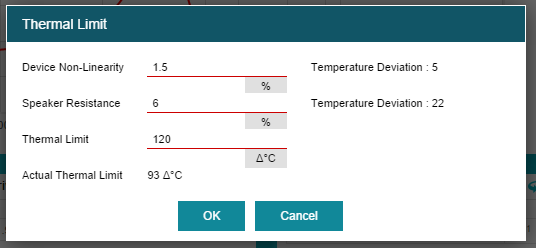Other Parts Discussed in Thread: TAS2563, TAS2781
Tool/software:
when the process is arrive to thermal char, we always encounter below question, the IT department also cannot resolve it, so could you tell me how to resolve it ?
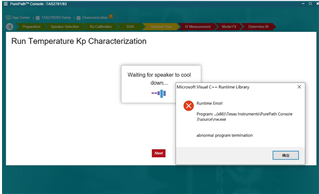
Tool/software:
when the process is arrive to thermal char, we always encounter below question, the IT department also cannot resolve it, so could you tell me how to resolve it ?

Hi Gary,
I am wondering if something went wrong during the installation of the PPC3? the PPC3 installer, in addition to PPC3 should install the Matlab compiler runtime and the Microsoft visual C++ runtime.
A few things to try
Regards,
Arthur
Hi Gary,
Looks like VC++ redistritube is not installed as expected. It will be downloaded and installed as part of ppc3 installation. Maybe there was some issue with the installation. I will send you the vc++ exe via email separately. You can install it separately and retry.
Regards,
Peter
Hi Gary,
Could you please attempt to uninstall PPC3 completely and try a new install?
do you have a second PC available? can you try on a separate PC?
Regards,
Arthur
Hi Gary,
when you met this issue, what load was used? the speaker or other load like resistor?
Br,
Wenbin
Hi Gary,
just want to check again.
1 the tuning or other modules works fine.
2 during the characterization, the first several steps works fine. can you share the Re results?
3 the issue happens immediately when you step in this step, or after a long time when it go into this step?
Br,
Wenbin
Hi Gary,
it is strange that 3 separate PC are showing the same issue. is it possible that your company IT is blocking the install of the VC++?
did you manually install the VC++ on the 3 machines you tested?
I will check once with our PPC3 team to make sure you have the latest VC++ version
Regards,
Arthur
Hi Arthur,
Your colleage have give me a VC++ , I still have the same problem after installation.
The 3 separate PC did not have the same problem. The other two with Windows 11 systems directly went black and exited.
my PC is the win7 system, above problem will arise.
Gary,
this version is very old at this point. I will share with you the latest version.
Regards,
Arthur
hi Gary,
Please use this version
https://tidrive.ext.ti.com/u/zIPG1gODxkneg8bR/ed3c1bec-bf4a-4755-b789-a7f417977773?l
access code: D21mC'Vf
regards,
Arthur
Gary,
for the Kp Char 10s is OK!. this is just the first step in the larger thermal char process. a longer tone will be used later in the characterization process!
Regards,
Arthur
Gary,
TAS2781 has a new thermal controller and thermal characterization process compared to TAS2563.
during the thermal characterization process the speaker may not heat all the way to Tmax and it is OK. however, your plot still seems low.
How are you powering the EVM? what is the PVDDH voltage you are applying to the speaker?
you may also try increasing the speaker rated power. since it is 10W your speaker may be hard to heat up by TAS2781 if the full 16V device gain is not used. i would suggest you use a PVDDH voltage like 18V connected to banana connectors from a dedicated bench supply
Regards,
Arthur
Hi Arthur,
I connected an external 19V power supply to the PVDDH, the thermal characterization result is shown in the below image :
1. I think the Max temperature is still small, even though the power has reached 15W;
2. Why is the power abnormally high in the first few seconds?
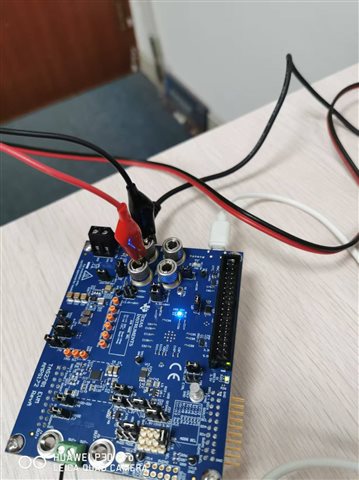
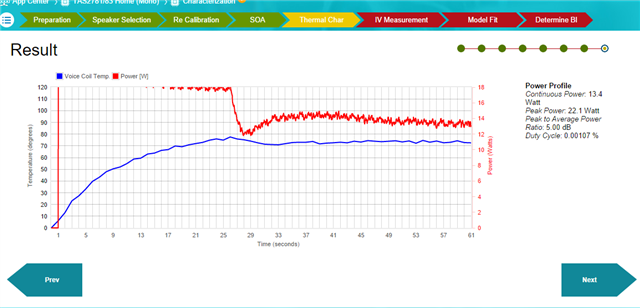
Hi Gary,
Apologies for the delay as i was out of the office last Friday
this results you are sharing now look expected - even through it is not reaching to the Tmax during characterization.
What have you changed? only making PVDDH = 19V?
have you increased the "rated power" parameter in the Thermal characterization panel? - previously you were entering 10W.
by increasing this you can cause the thermal characterization to settle at a higher temperature. - this value is only being used by the thermal characterization to determine the signal level to be used. if you increase it the characterization will result in higher thermal controller gains and therefore a higher settled temperature.
Regards,
Arthur
Hi Arthur,
Yes, I only make PVDDH = 19V.
I still have below question:
1. I want to know why the temperature hasn't risen yet when it hasn't reached its maximum value.
2. My results now look expected, does it mean thermal resistance and capacitance also can be calculated from my above characterization result?
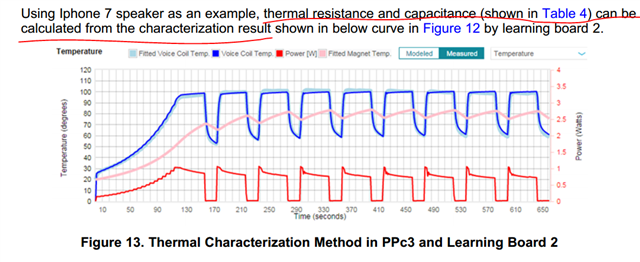
Gary,
Thermal resistance and capacitance are not being used by the new thermal controller in TAS2781 compared to TAS2563.
The TAS2781 thermal characterization it is not expected that the speaker will reach the Tmax during the thermal characterization process. the thermal char is leaving some margin to give a smooth thermal controller tuning across all types of speakers.
If you want to make the thermal controller more aggressive you can increase the "rated power" during the characterization process. OR you can fine tune thermal controller gains manually
To tune the thermal controller manual
Pgain - this is the dominant gain of the thermal controller. it will control the initial rise time and settling temperature
IG1 - this gain will apply positive pressure to the speaker temperature(more output power) when the speakers temperature is below Tmax
IG2 - this gain will apply negative pressure to the speaker temperature (lowers the output power) when the speakers temperature is near Tmax
Integral Cutoff % (IC%) - Integral limit of the PI controller.
1) PG =0.1, IG1 = 0 IG2 = 0 IC%
2) play a tone 0dBFS at the frequency above F0 which is the lowest impedance (typically 2-3kHz)
3) record the speaker temperature and voltage sense in the verification window of PPC3. likely PG is too low if speaker is not heating quickly. and PG1 is too high if overshoot/oscillations/pumping are seen. try to fine tune the PG value. and remember at this point IG1 = IG2 = IC% = 0
4) repeat steps 2 and 3 until desired temperature and output voltage profile are found
5) now that we have a value for PG. for example PG = 0.4. let the speaker cool to room temperature and play the same 0dBFS tone once more for 30 seconds and see what the temperature settles at. make note of the temperature in delta degrees. for example if speaker Tmax is 100C, and ambient temperature is 25C then Tmax(delta) = 75C. if the speaker settles at 60C(delta) then take the ratio. (60/75)*100% = 80%. this is the integral cutoff percent. enter this value in PPC3.
6) with the same example PG value of 0.4. lets calculate the IG1 and IG2 values. currently the entire loop gain is in PG we will spread it into IG1.
7) further fine tuning can be done if needed. for example. if after step number 6) the temperature is not increasing to TMax as quickly as desired increase the IG1. and if the temperature is overshooting Tmax go back to step 3) and use a smaller PG (smaller loop gain)
Regards,
Arthur
Hi Arthur,
Thanks for your detailed answer,and I tried as you said:
1. My speaker is larger, the resonant frequency is around 300Hz, so the 3000Hz tone is inappropriate,can I change it?
2. In the PPC3 you gave me, the PG IG... will only appear after I finished all the steps, I change the value as below image and retry thermal char, but the result will not change. So where can these values be changed?
Hi Gary,
1. My speaker is larger, the resonant frequency is around 300Hz, so the 3000Hz tone is inappropriate,can I change it?
Yes, 3kHz is typical for the <4W speakers we deal with typically use. for your speaker just use whichever frequency above the resonant frrequency(F0) is the lowest impedance.
2. In the PPC3 you gave me, the PG IG... will only appear after I finished all the steps, I change the value as below image and retry thermal char, but the result will not change. So where can these values be changed?
With the steps that i recommended. we will not be using the thermal char process. but rather change the PG/IG values. and then visit the "tuning and audio processing" panel to load the new configuration. and then play a tone with media player to view the speaker heating.
Speaker thermal profile can be viewed by selecting the "V" button on the bottom of PPC3 window while in the "Tuning and Audio processing" Panel
300Hz is not proper for heating the speaker. you want to use a high frequency tone which will cause the speaker to heat quickly.
i recommended 3kHz because this is the frequency which will heat most small speakers very quickly. if your speaker has a higher inductance then we can use a lower frequency like 1.5-1.8kHz.
play a tone at the frequency which is the lowest impedance above the F0
Regards,
Arthur
Hi Arthur,
I play a 0dB tone in "Tuning and Audio processing", and the audio palyer volume have turn to largest, the computer volume also have set to 100, but the output power of TAS2781 EVM board is just 3W, a 19V external power supply have connected to the PVDDH, the rated power of speaker is 10W, so how can I improve the output power?
Gary have you done this after performing the Characterization process in PPC3? if the speakers Re and other parameters are not updated correctly from the char process then this could be causing the audio to be limited
Arthur,
Yes, I have finished the Characterization process, the PPC3 file I have saved is shown in the attachment, I try to play a 0dB tone in "Tuning and Audio processing" module, and then I play a music, the results of the two are shown in the below figure, When playing music, the power occasionally exceeds 10W, but when playing single-frequency audio, it doesn't reach the rated power of 10W. I don't understand why?
Hi Gary. I see the voltage is limited. Can you please provide the PPC3 file to me?
What is the frequency of the tone?
Hi Gary.
Sorry i see you provided the file.
I know the issue. you have entered the speaker resistance variance as 6%. this means the algorithm is limiting the speakers temperature to ensure that a worse case speaker (6% lower Re than the nominal value) will not be burnt. the algorithm is limiting the temperature to 93C which is what we see in the temperature plot.
Can you please set speaker resistance to 0%? this should allow the speaker to heat to 115C.
